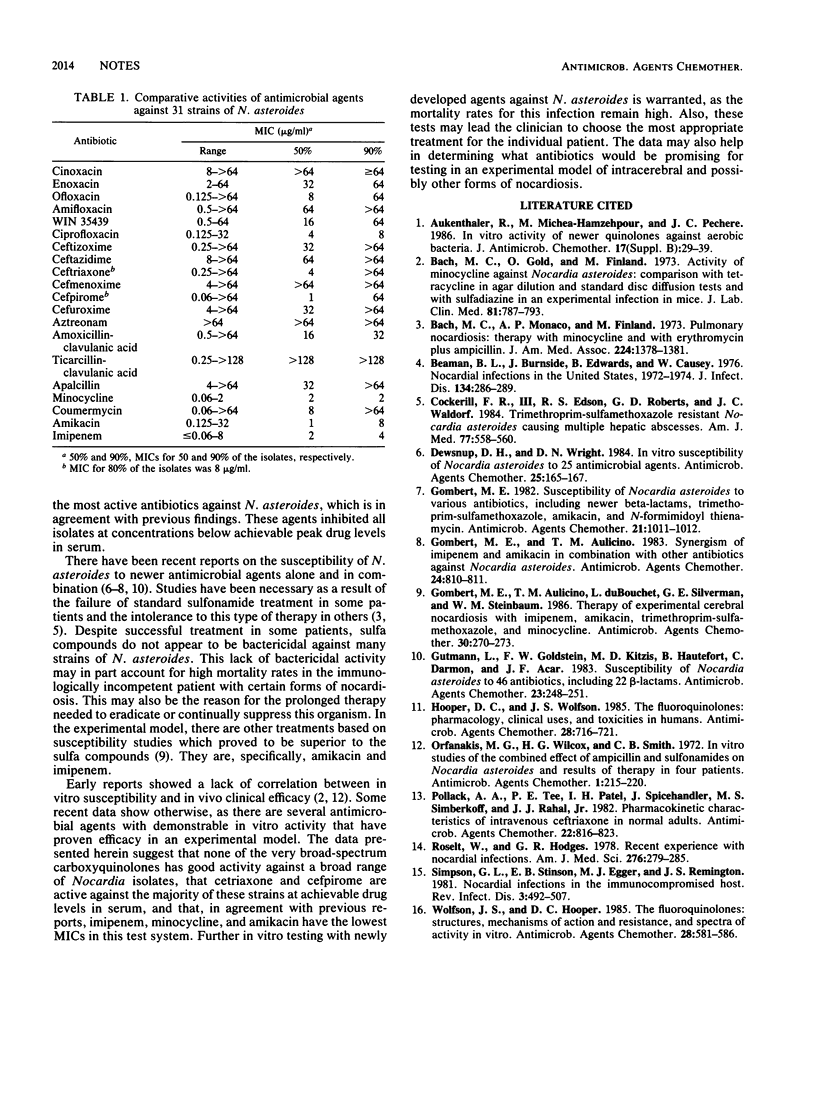Abstract
The susceptibility of 31 strains of Nocardia asteroides to various quinolones and beta-lactams, as well as coumermycin, amikacin, and minocycline, was determined by the agar dilution technique. Ciprofloxacin was the most active fluoroquinolone tested on a weight basis, as it inhibited approximately 50% of the isolates at achievable drug levels in serum. Ceftriaxone and cefpirome were the most active cephalosporins in this system with MICs of 8 micrograms/ml for 80% of strains tested. Imipenem, amikacin, and minocycline were the most effective agents tested.
Full text
PDF

Selected References
These references are in PubMed. This may not be the complete list of references from this article.
- Auckenthaler R., Michéa-Hamzehpour M., Pechère J. C. In-vitro activity of newer quinolones against aerobic bacteria. J Antimicrob Chemother. 1986 Apr;17 (Suppl B):29–39. doi: 10.1093/jac/17.suppl_b.29. [DOI] [PubMed] [Google Scholar]
- Bach M. C., Gold O., Finland M. Activity of minocycline against Nocardia asteroides: comparison with tetracycline in agar-dilution and standard disc-diffusion tests and with sulfadiazine in an experimental infection of mice. J Lab Clin Med. 1973 May;81(5):787–793. [PubMed] [Google Scholar]
- Bach M. C., Monaco A. P., Finland M. Pulmonary nocardiosis. Therapy with minocycline and with erythromycin plus ampicillin. JAMA. 1973 Jun 4;224(10):1378–1381. doi: 10.1001/jama.224.10.1378. [DOI] [PubMed] [Google Scholar]
- Beaman B. L., Burnside J., Edwards B., Causey W. Nocardial infections in the United States, 1972-1974. J Infect Dis. 1976 Sep;134(3):286–289. doi: 10.1093/infdis/134.3.286. [DOI] [PubMed] [Google Scholar]
- Cockerill F. R., 3rd, Edson R. S., Roberts G. D., Waldorf J. C. Trimethoprim/sulfamethoxazole-resistant Nocardia asteroides causing multiple hepatic abscesses. Successful treatment with ampicillin, amikacin, and limited computed tomography-guided needle aspiration. Am J Med. 1984 Sep;77(3):558–560. doi: 10.1016/0002-9343(84)90121-9. [DOI] [PubMed] [Google Scholar]
- Dewsnup D. H., Wright D. N. In vitro susceptibility of Nocardia asteroides to 25 antimicrobial agents. Antimicrob Agents Chemother. 1984 Feb;25(2):165–167. doi: 10.1128/aac.25.2.165. [DOI] [PMC free article] [PubMed] [Google Scholar]
- Gombert M. E., Aulicino T. M. Synergism of imipenem and amikacin in combination with other antibiotics against Nocardia asteroides. Antimicrob Agents Chemother. 1983 Nov;24(5):810–811. doi: 10.1128/aac.24.5.810. [DOI] [PMC free article] [PubMed] [Google Scholar]
- Gombert M. E., Aulicino T. M., duBouchet L., Silverman G. E., Sheinbaum W. M. Therapy of experimental cerebral nocardiosis with imipenem, amikacin, trimethoprim-sulfamethoxazole, and minocycline. Antimicrob Agents Chemother. 1986 Aug;30(2):270–273. doi: 10.1128/aac.30.2.270. [DOI] [PMC free article] [PubMed] [Google Scholar]
- Gombert M. E. Susceptibility of Nocardia asteroides to various antibiotics, including newer beta-lactams, trimethoprim-sulfamethoxazole, amikacin, and N-formimidoyl thienamycin. Antimicrob Agents Chemother. 1982 Jun;21(6):1011–1012. doi: 10.1128/aac.21.6.1011. [DOI] [PMC free article] [PubMed] [Google Scholar]
- Gutmann L., Goldstein F. W., Kitzis M. D., Hautefort B., Darmon C., Acar J. F. Susceptibility of Nocardia asteroides to 46 antibiotics, including 22 beta-lactams. Antimicrob Agents Chemother. 1983 Feb;23(2):248–251. doi: 10.1128/aac.23.2.248. [DOI] [PMC free article] [PubMed] [Google Scholar]
- Hooper D. C., Wolfson J. S. The fluoroquinolones: pharmacology, clinical uses, and toxicities in humans. Antimicrob Agents Chemother. 1985 Nov;28(5):716–721. doi: 10.1128/aac.28.5.716. [DOI] [PMC free article] [PubMed] [Google Scholar]
- Orfanakis M. G., Wilcox H. G., Smith C. B. In vitro studies of the combined effect of ampicillin and sulfonamides on Nocardia asteroides and results of therapy in four patients. Antimicrob Agents Chemother. 1972 Mar;1(3):215–220. doi: 10.1128/aac.1.3.215. [DOI] [PMC free article] [PubMed] [Google Scholar]
- Pollock A. A., Tee P. E., Patel I. H., Spicehandler J., Simberkoff M. S., Rahal J. J., Jr Pharmacokinetic characteristics of intravenous ceftriaxone in normal adults. Antimicrob Agents Chemother. 1982 Nov;22(5):816–823. doi: 10.1128/aac.22.5.816. [DOI] [PMC free article] [PubMed] [Google Scholar]
- Rosett W., Hodges G. R. Recent experiences with nocardial infections. Am J Med Sci. 1978 Nov-Dec;276(3):279–285. doi: 10.1097/00000441-197811000-00004. [DOI] [PubMed] [Google Scholar]
- Simpson G. L., Stinson E. B., Egger M. J., Remington J. S. Nocardial infections in the immunocompromised host: A detailed study in a defined population. Rev Infect Dis. 1981 May-Jun;3(3):492–507. doi: 10.1093/clinids/3.3.492. [DOI] [PubMed] [Google Scholar]
- Wolfson J. S., Hooper D. C. The fluoroquinolones: structures, mechanisms of action and resistance, and spectra of activity in vitro. Antimicrob Agents Chemother. 1985 Oct;28(4):581–586. doi: 10.1128/aac.28.4.581. [DOI] [PMC free article] [PubMed] [Google Scholar]


